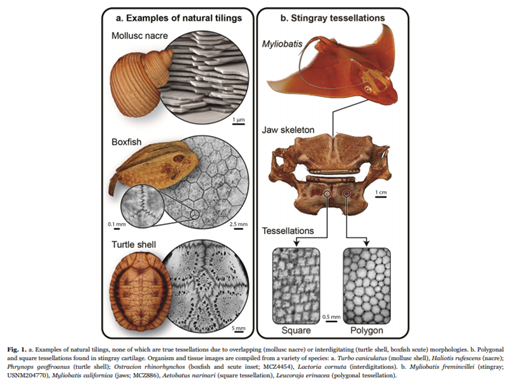Mechanical behavior of idealized, stingray-skeleton-inspired tiled composites as a function of geometry and material properties
Abstract
Tilings are constructs of repeated shapes covering a surface, common in both manmade and natural structures, but in particular are a defining characteristic of shark and ray skeletons. In these fishes, cartilaginous skeletal elements are wrapped in a surface tessellation, comprised of polygonal mineralized tiles linked by flexible joints, an arrangement believed to provide both stiffness and flexibility. The aim of this research is to use twodimensional analytical models to evaluate the mechanical performance of stingray skeleton-inspired tessellations, as a function of their material and structural parameters. To calculate the effective modulus of modeled composites, we subdivided tiles and their surrounding joint material into simple shapes, for which mechanical properties (i.e. effective modulus) could be estimated using a modification of traditional Rule of Mixtures equations, that either assume uniform strain (Voigt) or uniform stress (Reuss) across a loaded composite material. The properties of joints (thickness, Young’s modulus) and tiles (shape, area and Young’s modulus) were then altered, and the effects of these tessellation parameters on the effective modulus of whole tessellations were observed. We show that for all examined tile shapes (triangle, square and hexagon) composite stiffness increased as the width of the joints was decreased and/or the stiffness of the tiles was increased; this supports hypotheses that the narrow joints and high tile to joint stiffness ratio in shark and ray cartilage optimize composite tissue stiffness. Our models also indicate that, for simple, uniaxial loading, square tessellations are least sensitive and hexagon tessellations most sensitive to changes in model parameters, indicating that hexagon tessellations are the most “tunable” to specific mechanical properties. Our models provide useful estimates for the tensile and compressive properties of 2d tiled composites under uniaxial loading. These results lay groundwork for future studies into more complex (e.g. biological) loading scenarios and three dimensional structural parameters of biological tilings, while also providing insight into the mechanical roles of tessellations in general and improving the design of bioinspired materials.






